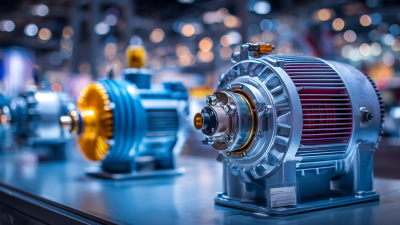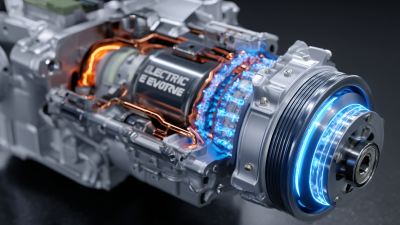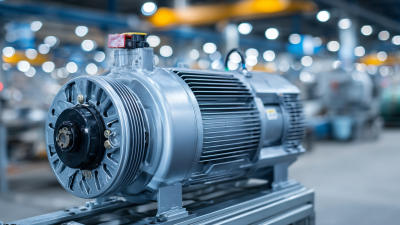The Future of Electric Motors: Innovations Driving the Next Generation of Sustainable Technology
As the world transitions towards more sustainable technologies, the future of electric motors is poised to play a pivotal role in this evolution. According to the International Energy Agency, electric motors consume nearly 45% of global electricity, making their efficiency paramount in reducing overall energy consumption and greenhouse gas emissions. Recent innovations in electric motor design and materials, such as the development of high-efficiency permanent magnets and advanced cooling techniques, are set to improve performance and decrease costs significantly. Furthermore, the global electric motor market is projected to reach $168 billion by 2025, driven by increasing demand in sectors like automotive, industrial machinery, and renewable energy systems. This landscape of advancements not only enhances the operational capabilities of electric motors but also aligns with global initiatives aimed at a cleaner, more sustainable future.

Innovative Materials Enhancing the Efficiency of Electric Motors
The advancement of electric motors is significantly influenced by innovative materials that enhance their efficiency and sustainability. A recent report from the International Energy Agency (IEA) highlights that improving electric motor efficiency by just 1% could lead to annual energy savings of approximately 30 terawatt-hours globally, which is equivalent to the annual electricity consumption of around 3 million households. These savings are critical as the world shifts toward greener technologies.
One of the most promising developments in electric motor technology is the use of advanced magnetic materials such as laminated silicon steel and amorphous steel. According to research from the Electric Power Research Institute (EPRI), these materials can improve efficiency by reducing energy losses during operation, thereby enhancing the overall performance of electric motors. Additionally, breakthroughs in composite materials are allowing for lighter and more durable motor components, which not only increase efficiency but also contribute to reduced manufacturing costs. As industries continue to seek sustainable alternatives, the integration of these innovative materials in electric motors will play a pivotal role in driving the next generation of sustainable technology.
The Future of Electric Motors: Innovations Driving the Next Generation of Sustainable Technology
This chart illustrates the efficiency improvements of electric motors over the years, highlighting the impact of innovative materials used in their development.
Advancements in Motor Design for Improved Sustainable Performance
The advancements in motor design are transforming the landscape of sustainable technology, particularly in electric motors. With the increasing demand for energy efficiency, manufacturers are innovating to reduce energy consumption and improve performance. According to a report by the International Energy Agency (IEA), improving the efficiency of electric motors could lead to savings of up to 600 terawatt-hours of electricity annually by 2040, highlighting the importance of advancements in this sector.
One significant development is the introduction of high-density permanent magnets and improved rotor designs, which can enhance the power-to-weight ratio and overall efficiency. For instance, a study by the Electric Power Research Institute (EPRI) indicates that using advanced materials can boost motor efficiency by approximately 20% compared to traditional designs. Additionally, manufacturers are now integrating smart technologies into electric motors, allowing for real-time performance monitoring and predictive maintenance, which can further enhance operational efficiency and sustainability.
Moreover, the shift towards eco-friendly manufacturing processes is noteworthy. A Life Cycle Assessment (LCA) conducted by the National Renewable Energy Laboratory (NREL) reveals that optimizing motor design with a focus on recyclable materials can significantly reduce environmental impact. In this evolving landscape, the intersection of innovative design, energy efficiency, and sustainable practices positions the electric motor industry at the forefront of the green technology revolution.
The Future of Electric Motors: Innovations Driving the Next Generation of Sustainable Technology - Advancements in Motor Design for Improved Sustainable Performance
| Innovation Type | Description | Expected Impact | Sustainability Index | Implementation Year |
|---|---|---|---|---|
| High Efficiency Motors | Motors designed to minimize energy loss during operation. | Reduces energy consumption by up to 30%. | 8.5/10 | 2025 |
| Integrated Power Electronics | Combines motor and power electronics into one unit. | Improves overall system efficiency and reduces size. | 9.0/10 | 2023 |
| Biomimetic Design | Motor designs inspired by natural systems for enhanced performance. | Greater efficiency and adaptability in varying conditions. | 7.0/10 | 2026 |
| Advanced Materials | Next-gen materials that improve heat resistance and reduce weight. | Enhances motor life and performance under extreme conditions. | 8.0/10 | 2024 |
| Smart Monitoring Systems | Incorporates IoT technologies for real-time performance tracking. | Enhances predictive maintenance and optimizes usage. | 8.8/10 | 2022 |
Integrating Smart Technologies in Electric Motor Systems
The integration of smart technologies in electric motor systems is transforming the landscape of sustainable technology. As the demand for efficient and environmentally friendly solutions rises, manufacturers are increasingly embedding advanced sensors, IoT connectivity, and AI-driven analytics into electric motors. This enables real-time monitoring of performance, energy usage, and operational conditions, allowing for predictive maintenance and optimized efficiency. The ability to analyze vast amounts of data helps in identifying patterns that lead to innovations in design and functionality.
Furthermore, smart technologies facilitate the seamless integration of electric motors into broader energy systems, enhancing their adaptability in various applications. For instance, with the use of machine learning algorithms, motors can learn from past operations and environmental factors to adjust their performance dynamically.
This adaptability not only boosts energy efficiency but also prolongs the lifespan of the motor. As industries shift towards smarter, greener technologies, the role of electric motors equipped with integrated smart technologies will be pivotal in driving sustainability forward.
Exploring Renewable Energy Sources for Electric Motor Power
As the demand for electric vehicles (EVs) continues to soar, the focus on renewable energy sources for powering electric motors becomes increasingly critical. Recent initiatives in regions like South Sumatra underline the significant advancements in integrating renewable energy into the energy mix, with local efforts achieving substantial targets. This commitment to harnessing solar and wind energy not only supports sustainable transportation but also paves the way for reducing reliance on fossil fuels, fostering a greener future for mobility.
Moreover, experts within the EV industry highlight the importance of developing robust charging infrastructures to support the growing number of electric vehicles. Innovations in sustainable hybrid systems are being explored to ensure effective electricity supply to electric vehicle charging stations (EVCSs), particularly in regions such as Çukurova, Turkey. By maximizing the utilization of renewable energy sources, these hybrid systems can enhance energy resilience and sustain the growth of the EV market, fueling both technological advancements and environmental benefits.
The Role of Electric Motors in the Transition to Green Transport
Electric motors are at the forefront of the transition to green transport, playing a pivotal role in reducing carbon emissions and promoting sustainability. According to a report by the International Energy Agency (IEA), electric vehicle sales surged by 41% globally in 2020, accounting for about 4.6% of the total vehicle market. This growth momentum is driven by improved electric motor technologies that enhance efficiency and performance.
Innovations such as permanent magnet motors and integrated motor-drive systems are reducing energy consumption and extending the range of electric vehicles, making them increasingly viable for consumers.
The advent of electric motors in public and private transport systems is also transforming the logistics sector. A study by McKinsey estimates that full-electric trucks could save fleet operators up to 40% in total cost of ownership compared to traditional diesel trucks. Furthermore, advancements in fast-charging technology alongside the growing infrastructure for electric vehicles will undoubtedly expedite the shift toward electrification in transportation. As industries continue to invest in research and development, the future of electric motors looks promising, positioning them as a sustainable solution in combating climate change and enhancing the efficiency of transportation systems worldwide.
Related Posts
-

Exploring Electric Motors Innovations at the 2025 China Import and Export Fair
-

What Are the Latest Innovations in Electric Motors Driving Industry Efficiency and Sustainability
-

The Ultimate Guide to Understanding 3 Phase Electric Motors: Efficiency, Applications, and Benefits
-

Understanding the Role of 3 Phase Electric Motors in Modern Industrial Applications
-

Top Strategies for Enhancing Circuit Breaker Performance and Reliability in Industrial Applications
-

Understanding the Benefits of VFD Drive Technology in Modern Industries
